✼
With more goods bought from Binuatan Creations added to the packs of cashew from the market loaded on our taxicle, we travelled for about 20 minutes from Sta. Monica to the Iwahig Firefly-Watching Ecotourism and Wildlife Park in Iwahig, Puerto Princesa. The Park entrance a few meters off the highway is past the end of the old South Road Bridge that spans the Iwahig River.
 |
| Welcome sign looking out to the main road. |
The firefly-watching tour at the Eco Park, managed by the Iwahig Community Ecotourism Association, Inc. (ICETA), started in 2008. Established jointly by the ABS-CBN Foundation, Inc. through its former Palawan Ecotourism program manager, the late broadcaster and environmentalist Dr. Gerry Ortega, with the city government of Puerto Princesa and the Tourism Department, this community-led activity received the Gold Award (Ecotourism Project category) from the Pacific Asia Travel Association (PATA) in 2010. It won the award over 65 other nominees from the Asia-Pacific region.
I didn’t really know what to expect from this evening firefly tour at all—I didn’t know what this first-time visit to Palawan had in store for me either, much less of the Underground River tour scheduled for Day 3 that convinced me to fly there—but anyhow gamely told my companions who had previously been to Puerto Princesa that I was open to doing whatever or be brought to wherever provided some internal matters like meetings or initiating contact with local community networks or groups were dealt with for example, and/or reunions with friends based in the city were done.
With the reunions and brief meetings fulfilled, and some happy shopping by my companions plus key tours of the city accomplished that afternoon and the day before, this firefly tour was, quite surprisingly, to be the highlight of our day. It was, at least, very much of mine.
A game-changer
Since its inception, the term “ecotourism” has often been misappropriated or misconstrued. Anyone with a room to let and a vista to display can claim to provide “ecotourism” experiences as had been mine in previous other instances so I tend to take locations that brand themselves as such with a bit of circumscription.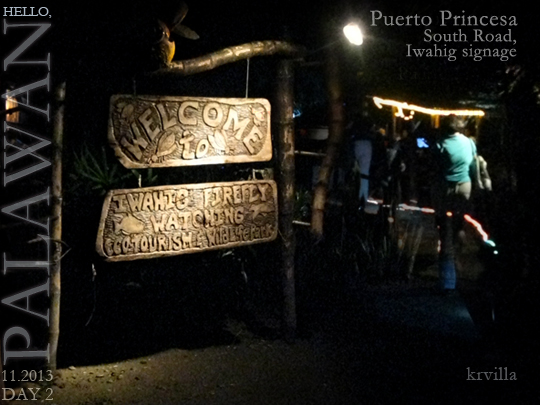 |
| Welcome sign by the footbridge that leads to the Information and registration area. |
For those reasons, and in light of the types of stops and tours we experienced in Puerto Princesa thus far, the Iwahig Firefly-Watching Tour, clichéd and simplistic as it may sound, is much a game-changer in the sense of what “ecotourism” and a “community-based” activity really is and feels like; and, for that matter, what are conveyed within the layers of an activity so straightforwardly and unpretentiously named “firefly-watching” as done by ICETA in the Iwahig River.
Better live
I’ve seen photos in blogs of tourists to this firefly tour just a day before arriving in Puerto Princesa so I had some idea of what it was to be like, i.e. of putting on the regulatory neon-orange life vests or dressing in rugged wear (have extra clothing or mosquito repellant handy, in case?), etc. but nothing near what have been written by them comes close to actually experiencing the evening Firefly tour.This tour is not as popular as the Underground River's or snorkeling in Palawan's waters. The Iwahig Firefly-Watching Ecotourism and Wildlife Park is not a Disneyland-theme park either and in contrast, is rather simple and looked well-kept. Because the Firefly tour is done at night, there isn’t much to see around as it is presumably required that lights—and noise—are kept low.
 |
| Iwahig Information and registration booth. |
Nyctophobes and aquapbohes, those who have fear of darkness and water—and especially of both—are well warned to take this tour with caution, by the way. (I’ve come to know of people who suffer from both (or are one or the other); while I am neither, I do adapt to darkness rather poorly.)
Anyhow, we went through the movement of registration and payment upon entrance (it costs Php 600.00 per boat for 3 people excluding the boatman). They don’t serve dinner so it's best to have a meal before taking the tour.
They will require IDs and log visitors' names. Visitors are then directed to the refreshments stall in the garden or go straight to the waiting area where names are called. There were just a few of us that Sunday evening, a moderate number compared to the usual head count they receive during peak seasons.
Visitors from the tour walk past us at the Information and registration booth.
|
A loosely-secured important notice notwithstanding, regulations are strictly implemented in the Park.
|
We didn't have to wait too long for our names to be called out but were required to wear the life vests supplied by them before getting into the banca (or bangka: a small wooden boat with outriggers). The receptionists then directed us to a small landing stage about 3 meters below the waiting area where the boats are docked. At the dock were men who help traffic visitors and provide assistance into the boat.
Operating rules only allow 3 visitors maximum per boat (there are not that many boats) and I would recommend calling the Park ahead for schedules especially during the peak seasons. Because there were four of us, we were divided into pairs and provided each a boatman who also was tour guide.
 |
| Waiting area leading to the dock. |
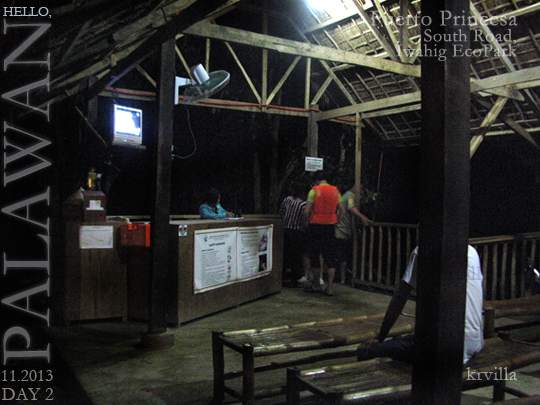 |
| Visitors ahead of us start to descend towards the dock. |
The rest of the men on the dock by the bank, about four or five of them who could very well be lifeguards and boatmen, too, then help push the boat gently into the darkness of Iwahig River but not before one of them called to us to pose for the camera. (He was the only one, I believe, allowed to shoot by the river with a flash.)
This starkly lit dock where the rest of the guides stayed would be the last and only lighted area one leaves behind in the boat. Without the benefit of clear sky and moon shine that evening—big thanks to the rains unloaded earlier that day—everything would have been near pitch-black just a few meters off it.
An enveloping enlightenment
In contrast to the Park’s waiting area lit by a fluorescent tube bulb (a bit harsh than the subdued garden area for me) where visitors, receptionists and a TV set together created a soft but dominating buzz, the boat ride on the river was instantaneously serene as we crossed the river to the other side.The first few minutes adjusting to the darkness and gentle motion of floating on a dark body of water was replaced subtly by an engulfing feeling of calm as our boatman’s soft tone and sense of humor helped restore confidence not just of one’s bearings but in him.
He paddled westward (which would place us on the northern bank) and along a think wall of Iwahig River mangroves. I was, by then, resigned to the fact that I wouldn't be able to take pictures of the fireflies in the darkness with the camera I had without activating the flash (or operating anything that gave off light) which actually turned out just as well or I would have been distracted by fumbling through buttons or settings and such.
The Nilad
I was pleasantly surprised to learn that the nila or nilad (Yamstick Mangrove, Scyphiphora hydrophyllacea) actually still exists. In fact I was a bit thrilled to feel surrounded by it in abundance because in Manila up in Luzon, the nilad, said to have thrived along the Pasig River banks in the pre-Spanish times, has all but disappeared due to the toxic state the river has transformed into. As such, the nilad plant has achieved a near-mythical status as it now exists mostly in textbooks or classroom discussions about history. Schools, I think, should emphasize that nila/nilad can still be found in places outside of Manila like Iwahig in Puerto Princesa.
On hindsight, I may actually have seen a nilad plant but didn’t know it. What I know is when “nilad” is mentioned and in connection to the history of Manila, that it evokes images from the pages of Fr. Manuel Francisco Blanco’s Flora de Filipinas, the richly illustrated botanical book he wrote in the 1800s in the San Agustin Church garden that now bears his name, in Intramuros, City of Manila.
 |
| The Nila/Nilad plant of Fr. Blanco's Flora de Filipinas, Illustrated (Deluxe) Ed. (1875) |
More boatman's stories
Although holding both minimum and maximum security detainees, our boatman proudly said that the Iwahig Penal Farm is, in principle, a prison without walls. With permission granted by the administration, some detainees are free to live with their families. They engage in farming, carpentry and other backyard trades within the institution's boundaries, the products of which are sold to tourists either in the Prison Farm itself or in stores outside it.
He said with pride, too, that unlike in Cebu where the famous dancing inmates are viewed by outsiders from within the confines of a building's viewing room, visitors are welcomed and are free to dance with the inmates in Iwahig.
In answer to my question, our boatman responded that about 1,000 or so residents, prison staff and other community members in Iwahig are collectively under a “special" barangay (the smallest government unit) of Puerto Princesa City. Members of this community make up ICETA which operates the Park and the tour, and are responsible for maintaining the Iwahig River and its environs.
Our guide then segued to talk about the fireflies, alitaptap in Tagalog—surprised that they’re actually beetles, who knew? (You did? Really? Well, I learned that they’re winged beetles not flies nor bugs, so there...)—and why they light up the way they do (it's bioluminescence, a "cold" light emitted via oxygen intake reacting with chemicals in their bodies). He quizzed us on which part of the firefly's body the luminescence is emitted from (their abdomens), and recited some Park regulations and of other river activities like canoeing or fishing in the daytime.
Command performance
In any case, our guide told us that the fireflies, specifically the males, use their bioluminescence to attract the females. The instance above, however, when they all lit up “on cue” upon our guide’s prompting was in reality a sign of defense against enemies that emit red light, a typical reaction of these insects to natural predators like “certain spiders with red glowing eyes,” he said.
What the fireflies did for us, therefore, was the ultimate show of force; of unity and strength in numbers which somehow reminded me of the formations made by the school of tiny moonfish in Finding Nemo.
On the third time our guide softly directed the fireflies in the dark mangroves to light up one last time was when he revealed to us the secret to his prompting a unisonous lighting up of the sprinkle.
Brief love and lifestory
"So why do fireflies glow in the first place? The answer to that is the same as the answer to the question of why some men wear so much darn cologne. To attract the ladies, of course!"
our boatman said that much as their glow is tied to their courting and mating, that oxygen is fundamental in producing the light they emit, driving his point across that their very survival (and that of the Iwahig community's) is even more critically connected to the fireflies' mangrove habitat than anything, as in the case of the recent typhoon Yolanda we touched upon and to which our boatman replied with certainty and without worry that the mangroves are there to protect them from the ravages of storm surges.
 |
| A firefly love story. Image references are indicated in the caption above. (krv.2013) (Complete image references and credits here) |
A deeper fascination (or, stories not by our boatman):
The Synchronous Fireflies of the Philippines
The guided Firefly-watching tour we did left me with a developing, if not deeper, appreciation of fireflies in general, and of those I saw in the Iwahig River tour in particular.
The groups of flashers we witnessed during the Firefly-watching tour are synchronous Philippine fireflies (there’s no such specific term, really; just “synchronous fireflies”) and most likely of the Coleoptera: Lampyridae: Luciolinae: Luciolini family.
As I've written and linked sources to names, places and events, and the scientific and alternate names of the plants referred to in this post to help readers know exactly what these are, I wanted to know which type it was of the 2,000 firefly species around the world that put on a show for us that evening in Iwahig. I don't remember our guide mentioning it besides him saying that there were two types in the area and I forgot to ask specifically for the name (it was supposed to have been mentioned to my friends who did the tour last year, though).
I found out, too, that female fireflies have shorter wings and are either low-flying or stay on the ground where they flash back in response to male fireflies they find “attractive.” (Not all fireflies, I learned, are flashy and visual; some types actually just excrete pheromones, aka the real firefly “cologne.”) Then, too, that their flashy love signals are only just the start of a more complex ritual of reproduction that happens when the lights are off.
Yet despite the initial introductions and additional information I learned about fireflies, I still couldn't find the Iwahig fireflies' name.
In search of the Iwahig firefly:
Thou art (possibly) "Pteroptyx sp."
Dear Fireflies of Iwahig,
I hope you liked the love story image above inspired by my trip to your River and the show you put on during our visit.
It wasn't easy finding your actual firefly variety and online searches didn't instantly lead to anything definite that referred to your name or type that we saw in Iwahig. I wondered why that was.
In the course of my searches I came upon more blogs and sites about fireflies and firefly-related activities from Japan, Hong Kong, Australia, Malaysia and pretty much the neighboring countries but the Philippines, with the exception of those written by visitors of the same tour we did but none mentioned your species. A few sites even wrote about academic symposia that discussed fireflies' presence in Southeast Asia while others linked to academic journals and researches with reference to Asian species. Full access is limited and require subscription, however.
But don't fret, here's something I think you'd like. Read on.
I hope you liked the love story image above inspired by my trip to your River and the show you put on during our visit.
It wasn't easy finding your actual firefly variety and online searches didn't instantly lead to anything definite that referred to your name or type that we saw in Iwahig. I wondered why that was.
In the course of my searches I came upon more blogs and sites about fireflies and firefly-related activities from Japan, Hong Kong, Australia, Malaysia and pretty much the neighboring countries but the Philippines, with the exception of those written by visitors of the same tour we did but none mentioned your species. A few sites even wrote about academic symposia that discussed fireflies' presence in Southeast Asia while others linked to academic journals and researches with reference to Asian species. Full access is limited and require subscription, however.
But don't fret, here's something I think you'd like. Read on.
Cheers,
from Metro Manila.
from Metro Manila.
Anyway, two sites that mention Philippine fireflies did come up, and one in particular, byteland.org, stood out. It is amazingly extensive it even has a story about fireflies in Mt. Apo in Southern Mindanao. This site is owned and maintained by Terry Lynch, an American naturalist and photographer, with special expertise in the study of firefly behavior, who I eventually ended up writing an email to, specifically to inquire if he knew or could ascertain the species in Palawan.
I subsequently also came upon palawaniana.net, owned and maintained by Palaweño Patrick Regoniel, an environmental scientist and professor at the Palawan State University and Palawan resident for more than 28 years. Dr. Regoniel's site is specific to Palawan and contains helpful entries about Palawan plants and animals we have yet to see (although none posted about the fireflies). As he seemed knowledgeable being well-rooted in Puerto Princesa, I sent him an email to inquire about the Iwahig fireflies as well. In reply, he wrote:
which seems to contradict any occurrence of the firefly species being specifically identified by the Iwahig guides to visitors as my friends last year."The species of firefly in Iwahig has not been identified yet. A few months ago, a Japanese researcher approached me and...asked locals about the species but nobody was able to tell him [to] which species the firefly belongs..." ~ Patrick Regoniel; Dec. 2013, in an email reply to the author.
In any case, Mr. Lynch, who also was approached by the Japanese student mentioned by Dr. Regoniel, replied to my email above with some news and a note, to quote: "...This identification was collaborated with [Dr.] Lesley Ballantyne...the world authority on fireflies from this region..."
So, for the curious, our Iwahig synchronous performers are possibly the Pteroptyx sp., based again on response by Mr. Lynch:
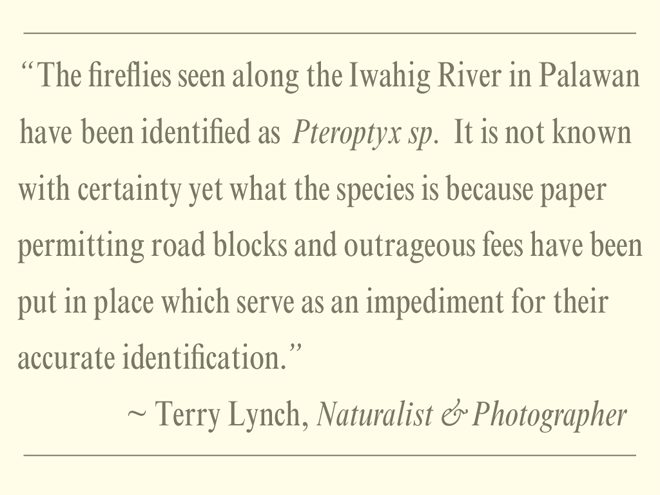 |
~ Source: Terry Lynch; Dec. 2013 in an email exchange with the author. See his ongoing project "Fireflies of Palawan:" Lynch, Terry (2013).
[*Blog author's note, 26 Dec 2013: "Processing" is deleted in favor of retaining Mr. Lynch's actual words. In my opinion, however, it may mean to cover all procedural and/or document-related processes applied by concerned institutions with regards specimen samples in the Philippines.]
[*Blog author's note, 27 Dec 2013: EDITS] See footnotes below.
|
but which also comes with cautionary advise about its specific variety:
"...We have a good idea what species they are but...not...until specimens are actually received by Lesley Ballantyne. However, with permitting road blocks preventing the simple posting of specimens, no one knows how long this will take..."Dr. Ragoniel, on the other hand, wrote me in relation to the researcher who approached him:
"...upon my advice, he [the researcher] requested permission from the Palawan Council for Sustainable Development (PCSD) to collect samples for identification. The person in-charge at PCSD said he should engage the services of the Philippine National Museum to this effect..."Right now, it just feels good to at least have something to identify the Iwahig fireflies with.
Greetings to the Pteroptyx sp. Family
The genus Pteroptyx is primarily restricted to mangroves and each stage of a species, lifecycle depends on different parts of the mangrove ecosystem (Nallakumar, 2002; Nada et al., 2008). The adults congregate on mangrove trees, especially at night, for mating purposes. After mating, the successful females fly to the muddy banks behind the vegetation and lay their eggs on the moist soil. The larvae, which feed on river snails, can be found typically five to 30 m from the display trees in the area where nipah and sago palms grow (Nada et al., 2008).
~ Source: Distribution and Abundance of Pteroptyx Fireflies in Rembau-Linggi Estuary, Peninsular Malaysia; Wan Faridah Akmal Wan Jusoh, Nor Rasidah Hashim and Zelina Zaiton Ibrahim, 2010
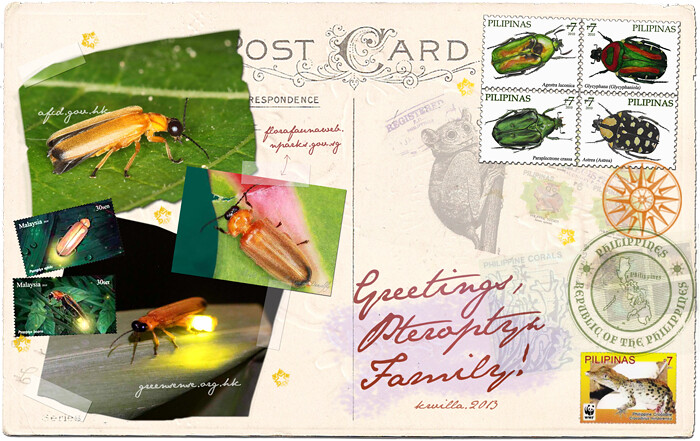 |
| [Image references] |
The Pteroptyx sp. has been definitely identified as fireflies found in Malaysia (and neighboring countries) which in all probability makes them relatives of those in Palawan in that case.
The fireflies in Mindanao, on the other hand, have been classified by Dr. Ballantyne and described in her 2008 paper as:
"The rare southeast Asian firefly genus Pygoluciola Wittmer was until now only known from the Malaysian states of Sabah and Sarawak, in published reports of 11 males (in five species) and 10 females (in three species). Now the genus is recorded for the first time outside Malaysia, from the Philippine island of Mindanao and the specimen number increases to 16 males (in six species) and 12 females (in four species)..."It was to her that specimens of the Mindanao fireflies were sent, according to the other site I came upon, angtribu.com.
I understand that the Palawan fireflies are more certain to be related to their Malaysian counterparts but efforts to properly ascribe their exact variety by way of sending firefly specimens are met with some difficulty, such as described in Dr. Ballantyne's 2008 paper as:
"Behavioural work should be able to proceed unhindered, but the behaviourists as well as the taxonomists need to know just what they are working on, or that at some stage in the future their material will be reliably identified, and not be hindered by an inadequate taxonomic structure. Firefly taxonomists, few as we are, face added complications – poor original descriptions, and difficulty in obtaining or even locating types. Apart from their age and fragility they are usually in European museums, an extra problem for the cash strapped antipodean taxonomist..."Not wanting to further delve upon the territory of experts, I therefore will leave the proper and precise naming of the Iwahig and all Philippine fireflies up to the them in the hope that these insects be properly accorded the same importance as their distant relatives in the region and thoroughly studied and understood in the context that they deserve.
~ Source: 01_Ballantyne(Pg1-9) 8 20/2/08, The Raffles Bulletin of Zoology 2008
Additionally, I advocate for local institutions to implement processes and methods that hasten scientific researches by foreign and local experts, authorities and students that, in the end, benefit the Philippines.
Firefly trails and fading stories
When one evening I asked a younger male cousin if we could go towards the tree that the they lit, he hesitated and told me that fireflies flocked to where spirits were supposed to abound. Whether they were supernatural spirits or those of the deceased he was uncertain. It was common belief among the few people I encountered growing up—fewer still any extended or focused conversations about fireflies—that they’d hear from older folks about fireflies in reference to dead people or other spirits.
Interestingly, this topic never came up during the Iwahig Firefly-watching tour. Only in my subsequent searches for this post did I learn that the Japanese traditionally regard their fireflies they call hotaru 蛍 of which there are two species, as souls of dead samurai soldiers of two warring clans in the 12th century.
The legend of the firefly in Philippine folklore, however, is different. It tells of the origin of fireflies as crystal fragments from a star on Alitaptap’s forehead.
Alitaptap, an enchanting non-mortal maiden, was the daughter Bul-an (moon) and Bitu-in (star). Her parents were a mystical couple sent by Bathala (supreme god) in response to people’s pleas for an end to drought. Despite Bul-an’s approval for Alitaptap to marry and save his town from blight, Alitaptap refused earning the ire of Bul-an who struck her in the forehead in anger and broke the star. When she fell lifeless, the broken star crystals took life and flew to the heavens (Summarized from source.)
I suppose the common Philippine folklore about fireflies, a story of love and obedience (and blind anger), was supplanted by the martial Japanese reference to souls of the dead partly as a consequence of socio-cultural transfer of belief systems and norms as what could have happened when Imperial Japan occupied the Philippine archipelago during the Pacific War.
It is probable that in their reverence to the fireflies, their own version was told to Filipinos who found their story fearful rather than reverent, or as stories told to drive Filipino children attempting to capture fireflies to flight.
Dealing with our own interventions
The fireflies I saw as a child are now gone from the backyard of the relative referred to above. Where have they gone?
Besides destructive practices of modern times that affect the fireflies' natural habitat: use of pesticides, land development and encroachment of coastal areas by settlers, recent studies indicate that artificial or electric lights created by buildings and dwellings in locations that still have fireflies have increasingly disrupted their mating behavior.
If the airborne flashing males on the lookout for females compete with other lights, the females are unable to distinguish the fireflies from the lights; if their courtship cycle is disrupted, then even the male with the strongest and largest spermatophores are unable to pass it on to the females that naturally carry the larvae which, in turn, grow to be fireflies. That’s not even mentioning their habitat, as firefly larvae feed on snails and worms during development stages and the adults need oxygen intake that react to the enzymes and chemicals in their bodies in order to flash. The cycle goes on.
In the end, we only have ourselves to ask and provide the answer to where they have gone (to the backwaters of Palawan, for one, which now requires us to pay out to see them, hopefully to remind us of basic respect for nature or the value we give or deny it).
Back to the tour: Stargazing
Our boatman-guide told us that the mangroves of Palawan provide them fortification from storm surges such as those that hit Manila’s Roxas Blvd. in 2011 (typhoon Nesat/Pedring) and the regions recently affected by Yolanda (Haiyan). Luckily for the main island of Palawan where Iwahig is located, Yolanda’s north-westward path spared it from its wrath but badly hit the northern Calamianes island group that includes Coron.
He paused paddling awhile as we approached the river bend that was slightly visible by the moonlight. The bend, he told me, headed towards the Penal Farm itself.
I could only imagine how far deep ahead the prison was from where we were and tried to grasp the depth of mangroves that enclosed it. It gave me an understanding of why this location was picked by the Americans for the penal institution as the mangroves and forests would have been so dense as to have nature provide its natural boundaries. It is this natural fortification that made it an open prison as it is such to this day.
It was difficult to get a sense of the distance we had covered in the darkness of that cool and peaceful November evening as we crossed the river towards the opposite bank .
As we glided eastward towards our point of origin, the scenery over the horizon was even more stunning. The cupola of stars against the crystal-clear night sky was something I've never seen before; even the clusters of minute stars, smaller than the smallest flicker of a firefly, were clearly visible. I was awestruck at the splendid panorama of stars.
From here, our guide talked about star formations and pointed to constellations and other clusters. Chingbee noted that this stargazing component was not included in last year’s Iwahig Firefly-watching boat ride.
The clever transition from fireflies to star talk, therefore, just makes total sense and shows that ICETA updates its guided tour operations and services that provide visitors added value.
Highly recommended
For the duration of our boatman’s sky talk while the firefly flickers were decreasing behind us, I wasn't aware that we were nearing the end of the Iwahig River tour. In fact it took me a few seconds more to get up from my seat and get off the boat when we reached the dock.
I found it difficult to move along from the dark, peaceful river setting to the starkness of the waiting area where another group of visitors waited for their turn.
Back in the garden is a small shed were the photos taken at the start of the ride can be viewed and bought. There were souvenir items for sale near the registration area, too, and proceeds of sales from both help in Park maintenance.
The Iwahig Firefly-watching tour is not top of visitors’ mind when planning a trip to Puerto Princesa or Palawan, but I highly recommend to every Palawan traveler to do themselves a favor and go for it.
As for me, I passed over the photos at the crowded booth. Instead, I bring the Iwahig River boat ride experience with me everywhere and will never look at the night sky the same way again.
POSTSCRIPT
We left the Iwahig Firefly-watching Ecotourism Park past 9 in the evening feeling slightly hungry. We travelled in our taxicle for about 30 minutes, maybe more, back to the city proper on the prowl for a place to eat.
We planned to go to a Imas, a vegetarian restaurant Chingbee and May’s sister went to in their previous visits. Maybe because it was a Sunday or maybe because we got to the city rather late in the evening that it was closed when we found it.
Our driver took us to another place on Rizal Avenue (I forgot its name now), past Kinabuch’s, but we got there minutes late so we ended up heading towards Kinabuch’s Grill and Bar.
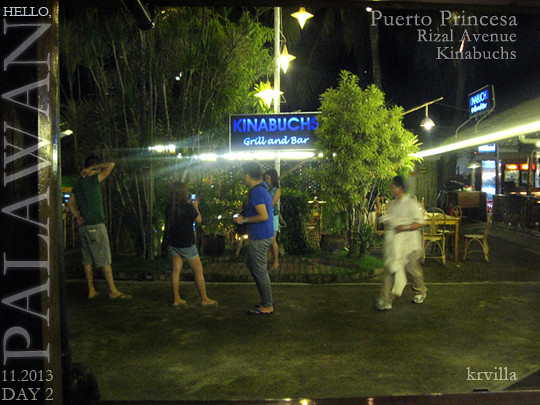 |
| Loud and lively. Not really the ideal place to be after a peaceful boat ride but open to welcome the starved. |
It’s not hard to miss Kinabuch’s because of its location near the airport and big parking area which makes it one of the most popular eating places for both tourists and locals. Kinabuch’s is similar to many of Metro Manila’s restaurants in look and feel and stays open later than most restaurants in Puerto Princesa City.
That late hour was still a busy Sunday night for Kinabuch’s, loud music and all. The servings are big, prices are reasonable and service is fast (they need to work on their restroom, though, particularly because it receives some of the biggest tour groups during the day).
I must admit it wasn’t the ideal scenario to end the evening from Iwahig but it at least made itself available for the hungry creatures that we were that night.
✼
Link references on this post (accessed Dec. 2013):
Link references on this post (accessed Dec. 2013):
| ▸ ANS-CBN Foundation, Inc.: 2008-2011 Accomplishment Report, "Milestones and Achievements '08-'11," p. 27: 2011 |
| ▸ Facebook Page: Justice for Dr. Gerry Ortega |
| ▸ Bruce Lieberman: Veteran won't let massacre be forgotten | The San Diego Union Tribune, 2009 |
| ▸ Faizza Farinna Tanggol: Doc Gerry’s legacy: Tourism with a heart |
| ▸ PATA: PATA announces 2010 Grand and Gold Award winners, 2010 |
| ▸ Smithsonian's National Museum of Natural History: Species Blancoanae: F.M. Blanco (1778-1845) by D.H. Nicolson & J.F. Veldkamp, (Accessed 2013) |
| ▸ Falvey Memorial Library: Bente Polites: Falvey Library exhibits rare work on Philippine flora, (Acc. 2013) |
| ▸ Augnet.org: Philippines: Intramuros - 01 |
| ▸ Augnet.org: Wall of Augustinian monastery that was destroyed by bombing in World War II. (IMAGE) |
| ▸ Bureau of Corrections: Iwahig Prison and Penal Farm |
| ▸ Library of Congress: Treaty of Paris of 1898 |
| ▸ Biolumisescentbeetles.com: Introduction to Bioluminescent Beetles |
| ▸ Discovery.com: Insects: Firefly |
| ▸ Mother Nature Network: Why do fireflies glow? |
| ▸ Mother Nature Network: Bioluminescence: Why organisms glow |
| ▸ Chanie Kirschner via Huffingtonpost.com: Why Do Fireflies Glow?, 05/25/2013 |
| ▸ Nationalgeographic.com: Firefly (Lightning Bug) Lampyridae |
| ▸ Alexander Wild: Ellychnia: Phenomenal Fireflies (IMAGE) |
| ▸ Firefly.org: Types of Fireflies |
| ▸ Tufts Now: Kim Thurler | Romancing the Firefly, 06/26/2012 |
| ▸ Agriculture, Fisheries and Conservation Department (AFCD) HK: The First Record in China of the Firefly Genus Pteroptyx, 2009 |
| ▸ ASEAN Review of Biodiversity and Environmental Conservation (ARBEC): Genus Pteroptyx |
| ▸ Byteland.org: Terry Lynch | Blinks and Links |
| ▸ Byteland.org: Terry Lynch | Study of the Fireflies and other Insects at Bagobo Woodlands |
| ▸ Patrick Regoniel: Palawaniana.net , About: Wikipilipinas |
| ▸ About Lesley A. Ballantyne: Researchgate Author profile |
| ▸ Byteland.org: Terry Lynch | Fireflies of Palawan: Eco-Tourism in Action |
| ▸ Fireflies of Palawan |
|
| ▸ Palawan Council for Sustainable Development (PCSD) |
| ▸ National Museum of the Philippines |
| ▸ Thai Society of Higher Education Institutes on the Environment (TSHE): Environment Asia: Distribution and Abundance of Pteroptyx Fireflies in Rembau-Linggi Estuary, Peninsular Malaysia (PDF) |
| ▸ National University of Singapore: Lesley A. Ballantyne | PYGOLUCIOLA SATOI, A NEW SPECIES OF THE RARE SOUTHEAST ASIAN FIREFLY GENUS PUGOLUCIOLA WITTMER (COLEOPTERA: LAMPYRIDAE: LUCIOLINAE) FROM THE PHILIPPINES (PDF) |
| ▸ Ang Tribu Bagobo Woodlands: Terry Lynch | Mt. Apo Fireflies |
| ▸ World Kigo Database: Fireflies (hotaru) (2005) |
| ▸ Philippineculture.ph: Legend of Alitaptap (PDF) |
| ▸ Alamat.com.ph: Lovedy Romero | And Alamat ng Alitaptap - Firefly |
| ▸ The Independent: Kathy Marks | Fireflies in decline as natural habitats are destroyed |
| ▸ About: Calamian Islands on Wikipedia |
| ▸ Mangrove print: Etsy via Surrender Dorothy |
| ▸ Boating Woodcut: Gutenberg.org/Project Gutenberg e-Book | David Livingstone, The Last Journals of David Livingstone, in Central Africa, from 1865 to His Death, Volume I (of 2), 1866-1868 |
| ▸ Firefly Larvae: Firefly.org | Facts about fireflies // From its actual SOURCE: Our deepest appreciation is extended to Terry Lynch, Editor of The Luminologist for permission to herein and only reprint the I-instar Photinus pyralis firefly larva photograph for non-commercial usage which is © 2013 by Terry Lynch and may not be reprinted without his prior written consent. // |
| ▸ Firefly Larva (big): Encyclopediathai.org: Firefly in the darkness at Klong Sunukhon, Samut Sakhon Province |
| ▸ Firefly Egg: Kampung Kuantan | The Life Cycle of The Fireflies Species (Pteroptyx Tener) |
| ▸ Xylocarpus Granatum: Prota.org |
| ▸ Nypa Fruticans: Wikimedia.org |
| ▸ Scyphophira Hydrophylacea (Nilad): Plantillustrations.org |
| ▸ National Parks Board Singapore: Pteroptyx valida (Olivier, 1883) |
| ▸ Agriculture, Fisheries and Conservation Department (AFCD) HK: The First Record in China of the Firefly Genus Pteroptyx |
| ▸ Beetles Stamp:Wang Lei | No.15&16 Covers - received on 2010/10/15 from Philippines |
| ▸ Philippine Tarsier: Daniel Enrique Ladioray| Mammals on Philfaunastamps.webs.com |
| ▸ Philippine Crocodile Stamp: colnect.com | Stamp catalog : Stamp ‹ Philippine Crocodile (Crocodylus mindorensis) |
| ▸ Malaysia Firefly Stamps: Philately News | Firefly |
| ▸ Corals: Alex Moises | Fish and Sea Animals on Stamps - Part II |
✼
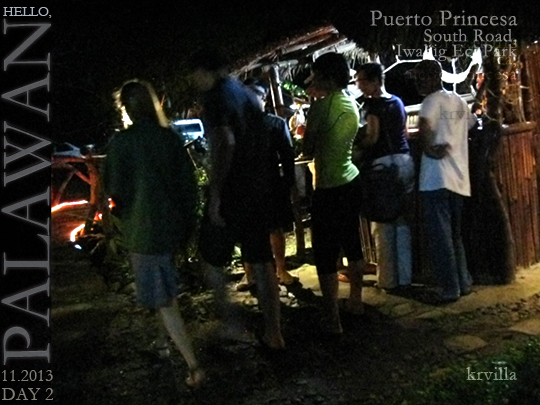
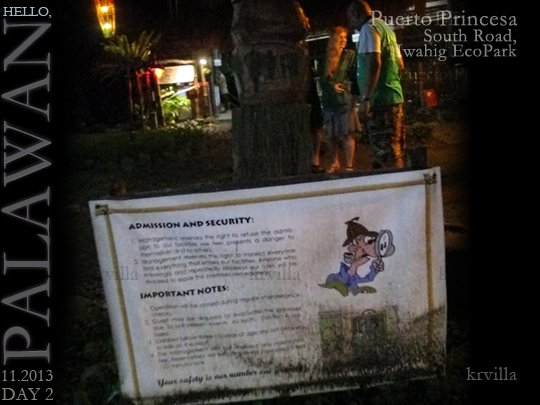
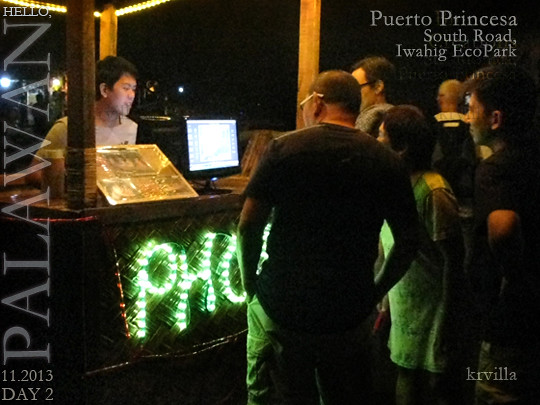


Pteroptyx has been identified as genus of firefly responsible for spectacular displays which thousands of tourists watch along the Iwahig River in Palawan, The Philippines. Identification was made by Terry Lynch, a Naturalist and Photographer in the United States of America, despite road blocks set up to make it almost impossible to identify insects and arthropods. The late Dr. Gerry Ortega who worked to save these fireflies was assassinated on 24 Jan. 2011 while working to expose government corruption, stop mining and preserve Palawan's rich biodiversity of flora and fauna from destruction by industrialist and developers. Lynch proposes that the people who love firefly-watching demand that specimens of these fireflies be sent for immediate identification and that if a new species is discovered it be named Pteroptyx ortega in honor of Dr. Ortega who gave his life working to develop sustainable ecotourism as an alternative to those industries which destroy the environment. http://www.byteland.org/palawan/save_the_fireflies_of_palawan.html
ReplyDeleteOn naming the new Palawan Pteroptyx firefly species "Pteroptyx ortega"
DeleteIt's an honor and a privilege to have a staunch environmental advocate like you, Mr Terry Lynch—aka Dr. Firefly—drop by and officially share not just the good news about our Pteroptyx Palawan fireflies but your views and support for the causes Dr. Gerry Ortega fought for.
To have the Pteroptyx fireflies as those along Iwahig River named after Dr. Ortega, I believe, would be bestowing him the highest honor; as well, a profound symbol of how fragile yet crucial the campaign is in nurturing and preserving our ecosystems.
I am aware of the forthcoming FIrefly Symposium 2014 in Florida, USA of which Dr. Leslie Ballantyne was once keynote speaker and that if Dr. Ortega were still alive, he would most likely be in attendance.
Salamat!
...
I invite my readers to check out Mr Terry Lynch's on-going work about the Palawan fireflies on his site.